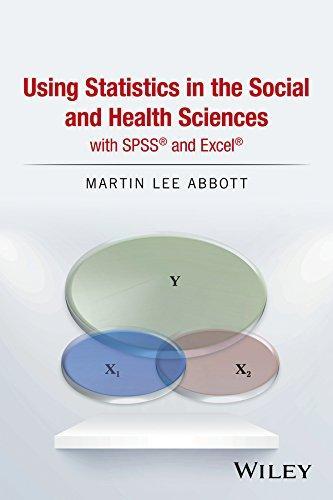
https://ebookmass.com/product/using-statistics-in-thesocial-and-health-sciences-with-spss-excel-1st/



https://ebookmass.com/product/using-statistics-in-thesocial-and-health-sciences-with-spss-excel-1st/

https://ebookmass.com/product/behind-the-hill-b-ivy-woods-woods/

ebookmass.com
TheNeedforDiagnostics,289
Non-ParametricANOVATests:TheKruskal–WallisTest,289 TermsandConcepts,292
DataLabandExamples(withSolutions),293
DataLab:Solutions,294
10FACTORIALANOVA297
ExtensionsofANOVA,297
ANCOVA,298
MANOVA,299
MANCOVA,299
FactorialANOVA,299
InteractionEffects,299
SimpleEffects,301
2XANOVA:AnExample,302
CalculatingFactorialANOVA,303
TheHypothesesTest:InterpretingFactorialANOVAResults,306
EffectSizefor2XANOVA:Partial �� 2 ,308
DiscussingtheResults,309 UsingSPSS® toAnalyze2XANOVA,311
SummaryChartfor2XANOVAProcedures,319 TermsandConcepts,319
DataLabandExamples(withSolutions),320
DataLab:Solutions,320
11CORRELATION329
TheNatureofCorrelation,330
TheCorrelationDesign,331
Pearson’sCorrelationCoefficient,332
PlottingtheCorrelation:TheScattergram,334 UsingSPSS® toCreateScattergrams,337 UsingExceltoCreateScattergrams,339
CalculatingPearson’s r ,341
The Z ScoreMethod,342
TheComputationMethod,344
TheHypothesisTestforPearson’s r ,345
EffectSize:theCoefficientofDetermination,347
Diagnostics:CorrelationProblems,349
CorrelationUsingSPSS® andExcel,352
NonparametricStatistics:Spearman’sRankOrderCorrelation(rs ),358 TermsandConcepts,363
DataLabandExamples(withSolutions),364 DataLab:Solutions,365
APPENDICES
AppendixASPSS® BASICS509 UsingSPSS® ,509 GeneralFeatures,510 ManagementFunctions,513 AdditionalManagementFunctions,517
AppendixBEXCELBASICS531 DataManagement,531 TheExcelMenus,533 UsingStatisticalFunctions,541 DataAnalysisProcedures,543 MissingValuesand“0”ValuesinExcelAnalyses,544 UsingExcelwith“RealData”,544
AppendixCSTATISTICALTABLES545
TableC.1: Z -ScoreTable(ValuesShownarePercentages–%),545
TableC.2:ExclusionValuesforthe T -Distribution,547
TableC.3:Critical(Exclusion)ValuesfortheDistributionof F ,548
TableC.4:Tukey’sRangeTest(Upper5%Points),551
TableC.5:Critical(Exclusion)ValuesforPearson’sCorrelation Coefficient, r ,552
TableC.6:CriticalValuesofthe �� 2 (Chi-Square)Distribution,553
REFERENCES555 Index557
Thestudyofstatisticsisgainingrecognitioninagreatmanyfields.Inparticular, researchersinthesocialandhealthsciencesnoteitsimportanceforproblemsolving anditspracticalimportanceintheirareas.Statisticshasalwaysbeenimportant,for example,amongthosehopingtoentercareersinmedicinebutmoresonowdueto theincreasingemphasison“ScientificInquiry&ReasoningSkills”aspreparationfor theMedicalCollegeAdmissionTest(MCAT).Sociology,alwaysrelyingonstatistics andresearchforitscoreemphases,isnowincludedintheMCATaswell.
Thisbookfocusessquarelyontheproceduresimportanttoanessentialunderstandingofstatisticsandhowitisusedintherealworldforproblemsolving.Moreover,my discussioninthebookrepeatedlytiesstatisticalmethodologywithresearchdesign (seethe“companion”volumemycolleagueandIwrotetoemphasizeresearchand designskillsinsocialscience;AbbottandMcKinney,2013).
Iemphasizeappliedstatisticalanalysesandassuchwilluseexamplesthroughoutthebookdrawnfrommyownresearchaswellasfromnationaldatabaseslike GSSandBehavioralRiskFactorSurveillanceSystem(BRFSS).Usingdatafrom thesesourcesallowstudentstheopportunitytoseehowstatisticalproceduresapply toresearchintheirfieldsaswellastoexamine“realdata.”Acentralfeatureofthe bookismydiscussionanduseofSPSS® andMicrosoftExcel® toanalyzedatafor problemsolving.
Throughoutmyteachingandresearchcareer,Ihavedevelopedanapproachto helpingstudentsunderstanddifficultstatisticalconceptsinanewway.Ifindthatthe greatmajorityofstudentsarevisuallearners,soIdevelopeddiagramsandfigures overtheyearsthathelpcreateaconceptualpictureofthestatisticalproceduresthat areoftenproblematictostudents(likesamplingdistributions!).
Anotherreasonforwritingthisbookwastogivestudentsawaytounderstandstatisticalcomputingwithouthavingtorelyoncomprehensiveandexpensivestatistical softwareprograms.SincemoststudentshaveaccesstoMicrosoftExcel,Idevelopeda step-by-stepapproachtousingthepowerfulstatisticalproceduresinExceltoanalyze dataandconductresearchineachofthestatisticaltopicsIcoverinthebook.1
Ialsowantedtomakethosecomprehensivestatisticalprogramsmoreapproachabletostatisticsstudents,soIhavealsoincludeda“hands-on”guidetoSPSSin parallelwiththeExcelexamples.Insomecases,SPSShastheonlymeanstoperform somestatisticalprocedures,butinmostcases,bothExcelandSPSScanbeused.
Herearesomeofthefeaturesofthebook:
1.Emphasisonthe interpretationoffindings.
2.Useof clearexamplesfrommyexistingandformerresearchprojectsandlarge databasestoillustratestatisticalprocedures.“Real-world”datacanbecumbersome,soIintroducestraightforwardproceduresandexamplesinordertohelp studentsfocusmoreoninterpretationoffindings.
3.Inclusionofa datalabsectionineachchapterthatprovidesrelevant,clear examples.
4. Introductiontoadvancedstatisticalproceduresinchaptersections(e.g., regressiondiagnostics)andseparatechapters(e.g.,multiplelinearregression) forgreaterrelevancetoreal-worldresearchneeds.
5.Strengtheningofthe connectionbetweenstatisticalapplicationandresearch designs.
6.Inclusionofdetailedsectionsineachchapterexplaining applicationsfrom ExcelandSPSS.
IuseSPSS2 (versions22and23)screenshotsofmenusandtablesbypermission fromtheIBM® Company.IBM,theIBMlogo,ibm.com,andSPSSaretrademarks orregisteredtrademarksof InternationalBusinessMachinesCorporation,registeredinmanyjurisdictionsworldwide.Otherproductandservicenamesmightbe trademarksofIBMorothercompanies.AcurrentlistofIBMtrademarksisavailable ontheWebat“IBMCopyrightandtrademarkinformation”atwww.ibm.com/legal/
1 OnelimitationtoteachingstatisticsprocedureswithExcelisthatthedataanalysisfeaturesaredifferent dependingonwhethertheuserisa“Mac”userora“PC”user.IamusingthePCversion,whichfeatures a“DataAnalysis”suiteofstatisticaltools.ThisfeaturemaynolongerbeincludedintheMacversionof Excel.
2 SPSSscreenreprintsthroughoutthebookareusedcourtesyofInternationalBusinessMachinesCorporation,©InternationalBusinessMachinesCorporation.SPSSwasacquiredbyIBMinOctober2009.
PREFACE xvii
copytrade.shtml.MicrosoftExcelreferencesandscreenshotsinthisbookareused withpermissionfromMicrosoft.IuseMicrosoftExcel® 2013inthisbook.3
IuseGSS(2014)dataandcodebookforexamplesinthisbook.4 TheBRFSS SurveyQuestionnaireandDataareusedwithpermissionfromtheCDC.5
3 ExcelreferencesandscreenshotsinthisbookareusedwithpermissionfromMicrosoft®
4 Smith,TomW.,PeterMarsden,MichaelHout,andJibumKim.GeneralSocialSurveys,1972–2012 [machine-readabledatafile]/PrincipalInvestigator,TomW.Smith;CoprincipalInvestigator,PeterV.Marsden;CoprincipalInvestigator,MichaelHout;SponsoredbyNationalScienceFoundation.NORCed. Chicago:NationalOpinionResearchCenter[producer];Storrs,CT:TheRoperCenterforPublicOpinion Research,UniversityofConnecticut[distributor],2013.1datafile(57,061logicalrecords) + 1codebook (3432pp.).(NationalDataProgramfortheSocialSciences,No.21).
5 CentersforDiseaseControlandPrevention(CDC). BehavioralRiskFactorSurveillanceSystemSurveyQuestionnaire.Atlanta,Georgia:U.S.DepartmentofHealthandHumanServices,CentersforDisease ControlandPrevention,2013andCentersforDiseaseControlandPrevention(CDC). BehavioralRiskFactorSurveillanceSystemSurveyData.Atlanta,Georgia:U.S.DepartmentofHealthandHumanServices, CentersforDiseaseControlandPrevention,2013.
suchlargeamountsofinformationbeenavailabletoassistresearchersandpolicy makersunderstandwidespreadpublicthinkingandbehavior.Onthechallengeside howeverareseveraldifficultquestions:
• Howaresuchdatatobeexamined?
• Docurrentsocialsciencemethodsandprocessesprovideguidancetoexamining datasetsthatsurpasshistoricaldata-gatheringcapacity?
• Arebigdatarepresentative?
• Dodatasetssolargeobviatetheneedforprobability-basedresearchanalyses?
• Dodecisionmakersunderstandhowtousesocialsciencemethodologytoassist intheiranalysesofemergingdata?
• Willthedecisionsemergingfrombigdatabeusedethically,withinthecontext tosocialscienceresearchguidelines?
• Willeffectsizeconsiderationsovershadowquestionsofsignificancetesting?
Socialscientistscanrelyonexistingstatisticalmethodstomanageandanalyze bigdata,butthe wayinwhichtheanalysesareusedfordecisionmakingwillchange. Onetrendisthatpredictionmaybehailedasamoreprominentmethodforunderstandingthedatathantraditionalhypothesistesting.Wewillhavemoretosayabout thisdistinctionlaterinthebook,butitisimportantatthispointtoseethatresearchers willneedtoadaptstatisticalapproachesforanalyzingbigdata.
Anotheremergingtrendforunderstandingandmanagingtheswellofdataistheuse ofvisuals.Ofcourse,visualdescriptionsofdatahavebeenusedforcenturies.Itis commonlyacknowledgedthatthefirst“piechart”waspublishedbyPlayfair(1801). Playfair’sexampleinFigure1.1comparesthedynamicsofnationsovertime.
Figure1.1comparednationsusingsize,color,andorientationovertime.Using thismethodforcomparinginformationhasbeenusefulforviewingthepatternsin datanotreadilyobservablefromnumericalanalysis.
Aswithnumericalmethods,however,thereareopportunitiesandchallengesin theuseofvisualanalyses:
• Canvisualmeansbeusedtoconveycomplexmeaning?
• Arethere“rules”thatwillhelptoinsureastandardwayofcreating,analyzing, andinterpretingsuchvisualinformation?
• Willvisualanalysesbecomedivorcedfromnumericalanalysissothatobservers havenowayofobjectivelyconfirmingthemeaningoftheimages?
Severalvisualdatasoftwareanalysisprogramshaveappearedoverthelastseveral years.Simplyrunninganonlinesearchwillyieldseveralpossibilitiesincludingmany thatofferfree(initial)programsforcatalogingandpresentingdatafromtheuser.I offeroneveryimportantcaveat(seethefinalbulletpointearlier),whichisthatitis

Figure1.1 WilliamPlayfair’spiechart. Source:https://commons.wikimedia.org/wiki/File :Playfair_piecharts.jpg.Publicdomain.
importanttoperformvisualdataanalysisinconcertwithnumericalanalysis.Aswe willseelaterinthebook,itiseasytointentionallyorunintentionallymisleadreaders usingvisualpresentationswhenthesearedivorcedfromnumericalstatisticalmeans thatdiscussthe“significance”and“meaningfulness”ofthevisualdata.
Thepresenceofsomuchrichinformationpresentsmeaningfulopportunitiesfor understandingmanyoftheprocessesthataffectthesocialworld.Whilemuchof thetimebigdataanalysesareusedforunderstandingbusinessdynamicsandeconomictrends,itisalsoimportanttofocusonthosedatapatternsthatcanaffectthe socialspherebeyondtheseindicators:socialandpsychologicalbehaviorandattitudes,changesinunderstandinghealthandmedicine,andeducationalprogress.These socialindicatorshavebeenthesubjectofagreatdealofanalysesoverthedecades andnowmaymakesignificantadvancesdependingonhowbigdataareanalyzedand managed.Onarelatednote,thesocialsciences(especiallysociologyandpsychology)arenowareasincludedinthenewMedicalCollegeAdmissionTest(MCAT), whichalsoincludesgreateremphasisupon“ScientificInquiry&ReasoningSkills.” Thematerialwewilllearnfromthisbookwillhelptosupportstudyintheseareas foraspiringhealthandmedicalprofessionals.
Inthisbook,Iintendtofocusonhowtouseandanalyzedataofallsizesand shapes.Whilewewillbelimitedinourabilitytodiveintotheworldofbigdatafully, wecanstudythebasicsofhowtorecognize,generate,interpret,andcritiqueanalyses ofdatafordecisionmaking.Oneofthefirstlessonsisthat datacanbeunderstood bothnumericallyandvisually.Whenwedescribeinformation,weareattemptingto
Nightingale(1858)ismostoftenrememberedasthefounderofmodernnursing. Sheisoftenrepresentedinpaintingsas“theladywiththelamp,”sinceshewas knowntowalkamongthebedsidescheckingonthesickandwoundedofthewar. ButNightingalewasalsoanastutestatisticianwhousedstatisticstocapturethedramaticneedinhospitalsduringtheCrimeanWar.Sheiscreditedasbeingoneofthe firsttousea“piechart”(moreaccurately,a“polarchart”).Figure1.3showscomparisonsinheroriginalpolarchartofdifferencesbetweensoldierswhodiedofbattlefield wounds(“red”wedgesnearthecenter)andthosewhodiedfromothercauses(“blue” wedgesmeasuredfromthecenterofthegraph)overtime.Therelationshipbetween thesegroupsfueledNightingale’seffortstoobtainfurtherfundingforsanitaryhospitalconditionssincethosewhodiedofinfectionsweregreaterinnumberthanthose dyingofbattlefieldwounds.
Manystudentsandresearchersareintimidatedbystatisticalprocedures,whichmay beduetofearofmath,problematicmathteachersinearliereducation,orthelackof exposuretoa“discovery”methodforunderstandingdifficultprocedures.Thisbook isanintroductiontounderstandingstatisticsinawaythatallowsstudentstodiscover patternsindataanddevelopingskillatmakinginterpretationsfromdataanalyses.I describehowtousestatisticalprograms(SPSSandExcel)tomakethestudymore understandableandtoteachstudentshowtoapproachproblemsolving.Ordinarily,a firstcourseinstatisticsleadsstudentsthroughtheworldsofdescriptiveandinferential statisticsbyhighlightingtheformulasandsequentialproceduresthatleadtostatistical decisionmaking.Wewilldoallthisinthisbook,butIplaceagooddealmoreattention onconceptualunderstanding.Thus,ratherthanmemorizingaspecificformulaand usingitinaspecificwaytosolveaproblem,Iwanttomakesurethestudentfirst understandsthenatureoftheproblem,whyaspecificformulaisneeded,andhowit willresultintheappropriateinformationfordecisionmaking.
Byusingstatisticalsoftware,wecanplacemoreattentiononunderstandinghowto interpretfindings.Statisticscoursestaughtinmathematicsdepartments,andinsome socialsciencedepartments,oftenplaceprimaryemphasesontheformulas/processes themselves.Intheextreme,thiscanlimittheusefulnessoftheanalysestothepractitioner.Myapproachencouragesstudentstofocusmoreonhowtounderstandand makeapplicationsoftheresultsofstatisticalanalyses.SPSSandotherstatistical programsaremuchmoreefficientatperformingtheanalyses;thekeyissueinmy approachishowtointerprettheresultsinthecontextoftheresearchquestion.
Beginningwithmyfirstundergraduatecourseteachingstatisticswithconventional textbooks,Ihavespentcountlesshoursdemonstratinghowtoconductstatisticaltests manuallyandteachingstudentstodolikewise.Thisisnotalwaysabadstrategy; performingtheanalysismanuallycanleadthestudenttounderstandhowformulas treatdataandyieldvaluableinformation.However,itisoftenthecasethatthestudentgravitatestomemorizingtheformulaorthestepsinananalysis.Again,there isnothingwrongwiththisapproachaslongasthestudentdoesnotstopthere. The
outcomeoftheanalysisismoreimportantthanmemorizingthestepstotheoutcome. Examiningtheappropriateoutputderivedfromstatisticalsoftwareshiftstheattention fromthenuancesofaformulatothewealthofinformationobtainedbyusingit.
ItisimportanttounderstandthatIdoindeedteachthestudentthenuancesof formulas,understandingwhy,when,how,andunderwhatconditionstheyareused. Butinmyexperience,forcingthestudenttoscrutinizestatisticaloutputfilesaccomplishesthisandteachesthemtheappropriateuseandlimitationsoftheinformation derived.
Studentsinmyclassesarealwayssurprised(ecstatic)torealizetheycanusetheir textbooksandnotesonmyexams.Buttheyquicklyfindthat,unlesstheyreally understandtheprinciplesandhowtheyareappliedandinterpreted,anopenbook isnotgoingtohelpthem.Overtime,theycometorealizethattheanalysesandthe outcomesofstatisticalproceduresaresimplytheingredientsforwhatcomesnext: buildingsolutionstoresearchproblems.Therefore,theirroleismoredetectiveand constructorthannumberjuggler.
Thisapproachmirrorstherecentnationalandinternationaldebateaboutmath pedagogy.Inourrecentbook, WinningtheMathWars (2010),mycolleaguesand Iaddressedtheseissuesingreatdetail,suggestingthat,whiletraditionalwaysof teachingmathareusefulandimportant,theemphasesofreformapproachesarenotto bedismissed.Understandingandmemorizingdetailarecrucial,butproblemsolving requiresadifferentapproachtolearning.
Ifocusonusingreal-worlddatainthisbook.Thereareseveralreasonsfordoingso, primarilybecausestudentsneedtobegroundedinapproachesforusingdatafromthe realworldwithalltheirproblemsand“grittiness.”Whenpeoplerespondtosurveys orinterviews,theyinevitablyfilloutinformationinwaysnotaskedbyinterviewers(e.g.,respondentsmaychoosetwopossibleanswerswhenoneisrequired,etc.). Moreover,transferringdatatoelectronicformmayresultinmiscodedresponsesor categorizationproblems.Researchersalwaysconfronttheseissues,andIbelieveit isimportantforstudentstoleavetheclassroomawareoftherangeofpossibleproblemswithreal-worlddataandpreparedfordealingwiththem.Ofcourse,muchofthe datawewillexaminewillalreadyhavebeenputinstandardforms,butotherresearch issueswillarise(e.g.,howdoIrecategorizedata,assignmissingcases,computenew variables,etc.?).
AnotherreasonIusereal-worlddataistofamiliarizestudentswithcontemporary researchquestionsinthesocialandhealthsciencefields.Classroomdataoftenare contrivedtomakeacertainpointorshowaspecificprocedure,whicharebothhelpful. ButIbelieveitisimportanttodrawthefocusawayfromtheprocedureperseand understandhowtheprocedurewillhelptheresearcherresolvearesearchquestion. Theresearchquestionsareimportant.Policyreflectstheavailableinformationona researchtopic,tosomeextent,soitisimportantforstudentstobeabletogenerate thatinformationaswellastounderstandit.Thisisan“active”ratherthan“passive” learningapproachtounderstandingstatistics.
DataLabsareaveryimportantpartofthiscoursesincetheyallowstudentsto takechargeoftheirlearning.Thisistheheartofdiscoverylearning.Understandinga statisticalprocedureintheconfinesofaclassroomisnecessaryandhelpful.However, learningthatlastsisbestaccomplishedbystudentsdirectlyengagingtheprocesses withactualdataandobservingwhatpatternsemergeinthefindingsthatcanbeapplied torealresearchproblems.
Somepracticeproblemsmayusedatacreatedforclassroomuse,butreal-world datafromactualresearchdatabaseswillenableadeepeningofunderstanding.Inadditiontonationaldatabases,Iuseresultsfrommyownresearchforclassroomlearning. Ineverycase,researchersknowthattheywilldiscoverknottyproblemsandunusual, sometimesidiosyncratic,informationintheirdata.Ifstudentsarenotexposedtothis real-worldaspectofresearch,itwillbeconfusingwhentheyengageinactualresearch beyondtheconfinesoftheclassroom.
Inthiscourse,wewillhaveseveraloccasionstocompleteDataLabsthatpose researchproblemswithactualdata.StudentstakewhattheylearnfromthebookmaterialandconductastatisticalinvestigationusingSPSSandExcel.Then,theyhavethe opportunitytoexaminetheresults,writeresearchsummaries,andcomparefindings withthesolutionspresentedattheendofthebook.
Theprojectlabsalsointroducestudentstotwosoftwareapproachesforsolvingstatisticalproblems.Thesearequitedifferentinmanyregards,aswewillsee inthechaptersthatfollow.SPSSprovidesadditionaladvancedprocedureseducationalresearchersutilizeformorecomplexandextensiveresearchquestions.Excel iswidelyaccessibleandprovidesawealthofinformationtoresearchersaboutmany statisticalprocessestheyencounterinactualresearch.TheDataLabsprovidesolutionsinbothformatssothestudentcanlearnthecapabilitiesandapproachesofeach.
Thisbookmakesuseofpublicallyavailableresearchdata.TheGeneralSocialSurveyorGSS1 isanationallyrepresentativesurveydesignedtobepartofaprogramof socialresearchtomonitorchangesinAmericans’socialcharacteristicsandattitudes. FundedthroughtheNationalScienceFoundationandadministeredbytheNational OpinionResearchCenter(NORC),theGSShasbeenadministeredannuallyorbiannuallysince1972.Asageneralsurvey,theGSSasksavarietyofquestionsonaseries oftopicsdesignedtotracktheopinionsofAmericansoverthelastfourdecades. Otherdatabaseswewilluseinthebookincludethefollowing:
• TheCentersforDiseaseControlandPrevention(CDC)conductstheBehavioral RiskFactorSurveillanceSystem(BRFSS)asahealth-relatedtelephonesurvey tomeasureAmericanresidents’healthconditions,healthbehaviors,anduseof preventativeservices.2
1 TomW.Smith,PeterMarsden,MichaelHout,andJibumKim.GeneralSocialSurveys,1972–2012 [machine-readabledatafile]/PrincipalInvestigator,TomW.Smith;CoprincipalInvestigator,PeterV. Marsden;CoprincipalInvestigator,MichaelHout;SponsoredbyNationalScienceFoundation.–NORC ed.–Chicago:NationalOpinionResearchCenter[producer];Storrs,CT:TheRoperCenterforPublic OpinionResearch,UniversityofConnecticut[distributor],2013.1datafile(57,061logicalrecords) + 1 codebook(3432pp.).--(NationalDataProgramfortheSocialSciences,No.21).
2 CentersforDiseaseControlandPrevention(CDC)(2013). BehavioralRiskFactorSurveillanceSystemSurveyData.Atlanta,Georgia:U.S.DepartmentofHealthandHumanServices,CentersforDisease ControlandPrevention.
Iemphasize“practicalsignificance”(effectsize)inthisbookaswellasstatistical significance.Inmanyways,thisisamorecomprehensiveapproachtouncertainty, sinceeffectsizeisameasureof“impact”intheresearchevaluation.Itisimportant tomeasurethelikelihoodofchancefindings(statisticalsignificance),buttheextent ofinfluencerepresentedintheanalysesaffordstheresearcheranothervantagepoint todeterminetherelationshipamongtheresearchvariables.
Thestatisticalapplicationswewilldiscussinthisbookare“workhorses.”Thisisan introductorytreatment,soweneedtospendtimediscussingthenatureofstatisticsand basicproceduresthatallowyoutousemoresophisticatedprocedures.Wewillnotbe abletoexamineadvancedproceduresinmuchdetail.Iwillprovidesomereferences forstudentswhowishtocontinuetheirlearningintheseareas.Hopefully,asyou learnthecapabilityofSPSSandExcel,youcanexploremoreadvancedprocedures onyourown,beyondtheendofourdiscussions.
Somereadersmayhavetakenstatisticscourseworkpreviously.Ifso,myhopeis thattheyareabletoenrichwhattheypreviouslylearnedanddevelopamorenuanced understandingofhowtoaddressproblemsineducationalresearchthroughtheuseof SPSSandExcel.Whetherreadersarenewtothestudyorexperiencedpractitioners, myhopeisthatstatisticsbecomesmeaningfulasawayofexaminingproblemsand debunkingprevailingassumptionsinthesocialandhealthsciences.
Often,well-intentionedpeoplecan,throughignoranceofappropriateprocesses, promoteideasthatmaynotbetrue.Further,policiesmightbeofferedthatwouldhave anegativeimpacteventhoughthepolicywasnotbasedonsoundstatisticalanalyses. Statisticsaretoolsthatcanbemisusedandinfluencedbythevalueperspectiveofthe wielder.However,policiesareoftengeneratedintheabsenceofcompellingresearch. Studentsneedtobecome“researchliterate”inordertorecognizewhenstatistical processesshouldbeusedandwhentheyarebeingusedincorrectly.
morecomplexthancanbeexplainedbytwovariables.Wethereforemustbeable to“see”patternsamongdatausingbothnumericalandvisualmeansthatunderlie seeminglysimplerelationships.
AswewilldiscussinChapter11,thereisabigdifferencebetween“correlation”and“causation.”Thisstatisticaladagehelpstopointoutthecomplexityof understandingthepatternsamongvariables.Justbecausetwovariablesarestrongly statisticallyrelateddoesnotmeanthatthereisacausalrelationshipbetweenthem. Causalityisdifficulttoprove.Inordertounderstandtheapparentcausalrelationship morefully,wemustlookat othervariablesthatmighthaveameaningfulbut“hidden” relationshipwithboth“visible”variables.Researchersusetheterm“spuriousness”to describewhetheranapparentrelationshipbetweentwovariablesmightbetheinfluenceofvariablesnotintheanalysis.Anexampleofspuriousnessistherelationship betweenicecreamconsumptionandcrime.1
Thereisapositiverelationshipbetweenratesoficecreamconsumptionandcrime; whenoneincreases,sodoestheother.Shouldweconcludethenthaticecreamconsumptionleadstocriminalbehaviorinacausalway?Spuriousnessmeansthatthere maynotatrueorgenuinerelationshipbetweenfactorsevenifitlookslikethereis. Some unobservedorunnoticedvariablemayberelatedtobothofthevariableswe can“see”(inthisexampleicecreamconsumptionandcrime),whichmaymakeit appearthatthe“visible”variableshaveacause–effectrelationship.
Inthisexample,icecreamconsumptionincreasesascrimeincreases;and, consequently,whencrimeincreases,sodoestheconsumptionoficecream.These twovariablesappeartobeconsistentlyrelatedtoeachother.Theyprobablydo nothaveacausalrelationship,however,sincebothicecreamconsumptionand crimearerelatedtoathirdfactor:temperature.Whentemperaturesrise,icecream consumptionincreases(peopleeatmoreicecreaminthesummerthanwinter).Also, whentemperaturesrise,crimeincreases.Ifweincludetheseadditionalrelationships inourstudy,thenwecanseethattheapparentcausalrelationshipbetweenicecream consumptionandcrimeisprobablyreallymoreanissueoftheweather;bothofthe variablesare“linked”bytemperature.
Withoutconsideringspuriousness,somemightbetemptedtoexplain whythereis acausalrelationshipbetweenicecreamconsumptionandcrime.Forexample,does icecreamleadtofeelingsofgrandeurorapropensityforaggression,whichcauses peopletocommitcrime?Orisitthatgoodicecreamissoexpensivethatpeople commitcrimesinordertosupporttheiricecreamhabit?Whichmakesmostsense? Althoughwecouldcomeupwithseveralreasons(mostlyfanciful)whyoneofthese variablesmightbecausallyrelatedtotheother,weneedtobecautious.
Thissituationleadstooneofthemostprofoundlessonsinsocialscience: objectivityisnecessarytopursueknowledgedispassionately.Ifweassumethereisarelationshipbetweenthingswithoutusingobjectivemeansofassessingthetruthofthe situation,thenwearesimplyimposingasubjectiveunderstandingofthesituationthat isnot“anchored”inscience.Somecallthisthe“procrusteanexercise”referencing themythologicalfigurewhoforcedpeopletoanironbedbyeitherstretchingthemto
1 ThisexampleandexplanationarediscussedinAbbottandMcKinney(2013).
Figure2.1 Thepossiblespuriousrelationshipbetweenicecreamconsumptionandcrime. fitorcuttingofftheexcess.Thus,bynottakinganobjectivestance,wemayhavea tendencytomakeapparentreality“fit”ourmentalpictureorsubjectiveassumptions.
Figure2.1showshowthepossiblerelationshipsamongicecreamconsumption, crime,andtemperature.Thetoppanelshowstheapparentrelationshipbetweenice creamconsumptionandcrime,withatwo-waylineconnectingthevariablesindicatingthatthetwoarehighlyrelatedtooneanother.Thebottompanelshowsthat, whenthethirdvariable(temperature)isintroduced,theapparentrelationshipbetween icecreamconsumptionandcrimedisappears,asindicatedbytheabsenceofaline connectingthem.
Identifyingpotentiallyspuriousrelationshipsisoftenquitedifficultandcomes onlyafterextendedresearch.Theresearchermustknowtheirdataintimatelyinorder tomakethediscovery.AnexampleofthisisastudyIconductedinastudyofindustrialdemocracyseveralyearsago.Itwasgenerallyacceptedinindustryatthetime that,ifworkersweregiventheabilitytoparticipateindecisionmaking,theywould havehigherjobsatisfaction(JS).Thiswasareasonableassumption,givensimilar findingsintheresearchliterature.However,themoreIexaminedmyowndatafrom workersinanelectronicindustry,themoreIquestionedthisassumptionanddecided toexplorethematterfurther.
Inoticedfrominterviewsthatmanyworkers didnotwanttoparticipateindecisionmaking,eventhoughtheyhadtheopportunitytodoso.Ithereforeanalyzed theoriginal“participation–jobsatisfaction”butthistimeaddedvariablesthatmeasuredworkers’attitudestowardtheirworkandadesireformanagement.Througha seriesofanalyses,Ifoundanumberofsurprisingresultsthat“modified”theoriginal assumptionofadirect(andcausal)relationshipbetweenparticipationandJS.Oneof thesefindingswasthataworker’s attitudetowardmanagementhadalottodowith theireventualsatisfactionlevels.Thoseworkerswhoparticipatedindecisionmakingandwhohadapositiveviewofmanagementshowedstrongersatisfactionthan thoseworkerswhodidnotsuchapositiveviewofmanagement.Thus,athirdvariable(viewofmanagement)thatwasnotoriginallyincludedinthesimplerelationship (participation–satisfaction)hadanimpactonthefindings.Thissubsequentanalysis discoveredapatterninthedatathatwasnot“visible”attheoutset.